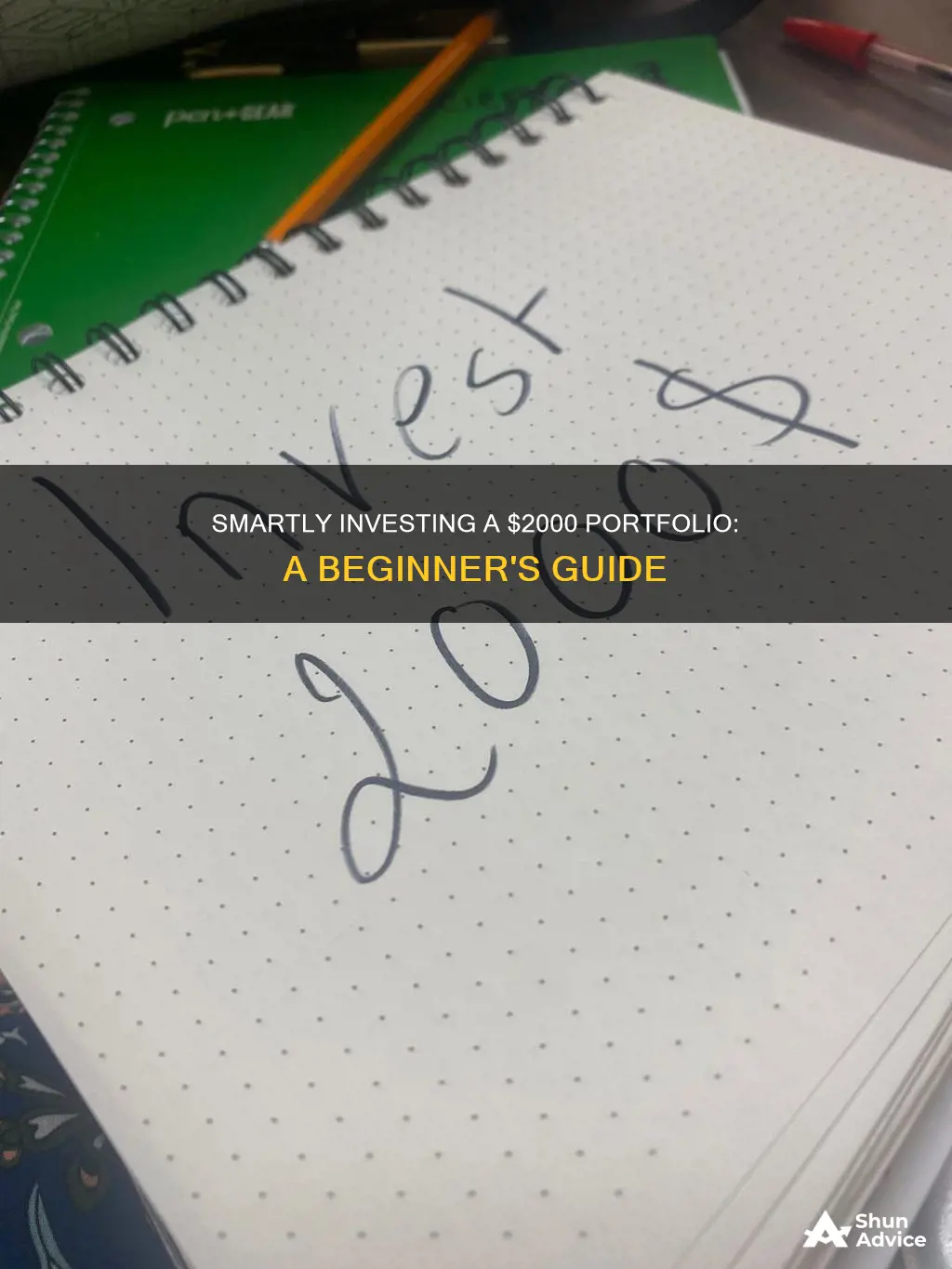
Investing $2000 can be a great way to grow your wealth and improve your financial situation. While it may seem intimidating, there are many options available to help you build a diverse portfolio.
Before investing, it is important to consider your financial goals, time horizon, and risk tolerance. Ask yourself whether you are investing for the long term or saving for a specific short-term goal, such as buying a house. Additionally, evaluate your risk appetite and whether you are comfortable with potential losses in exchange for higher returns.
Once you have a clear understanding of your investment objectives, you can explore various options, including stocks, exchange-traded funds (ETFs), mutual funds, bonds, and real estate investment trusts (REITs). You can also consider alternative investments such as artwork, cryptocurrency, or investing in yourself by acquiring new skills or starting a side business.
To get started, you may want to open a brokerage account or explore robo-advisors, which provide automated investment recommendations based on your goals and risk tolerance. Remember to always do your research and make informed investment decisions.
| Characteristics | Values |
|---|---|
| Amount | $2,000 |
| Investor Type | First-time investors, pre-retirees, young adults |
| Investment Options | Brokerage account, stocks, exchange-traded funds (ETFs), high-yield savings account, retirement account, bonds, real estate, robo-advisors, mutual funds, index funds, actively managed funds, REITs, education savings plan, corporate bonds, cryptocurrency |
| Investor Considerations | Goals, time horizon, circumstances, risk tolerance, tax advantages, fees, safety, historical performance |
What You'll Learn

Diversify your portfolio
Diversifying your portfolio is a crucial step in investing, as it helps to reduce your overall risk. Diversification means spreading your investments across various assets, industries, countries, and risk profiles. Here are some strategies to help you diversify your $2000 portfolio:
Spread Your Investments
When diversifying your portfolio, it is essential to spread your investments across different asset classes. This can include stocks, bonds, commodities, real estate, and more. By investing in a variety of assets, you reduce the risk of losing all your money if one particular asset or industry performs poorly.
Invest in a Variety of Industries
It is important to invest in companies from various industries, such as technology, energy, healthcare, and others. This diversification ensures that your portfolio is not overly exposed to the risks and fluctuations of any single industry.
Include International Investments
Diversifying your portfolio can also mean investing in companies from different countries. This type of diversification can help protect your portfolio from country-specific economic downturns or geopolitical risks.
Consider Different Risk Profiles
When building your portfolio, consider investing in a mix of large-cap, small-cap, dividend, growth, and value stocks. Each of these categories carries different levels of risk and potential returns, so including a variety can help balance your portfolio.
Use Index Funds or Exchange-Traded Funds (ETFs)
Index funds and ETFs are an easy way to achieve diversification. By investing in these funds, you instantly gain exposure to a diverse range of companies or industries. For example, investing in an S&P 500 index fund gives you access to 500 of the largest US public companies in a single investment.
Add Fixed-Income Investments
Fixed-income assets like bonds are an essential part of diversifying your portfolio. They help to lower volatility and reduce the overall risk profile of your investments. While they may reduce the potential returns, they also provide a hedge against market volatility and uncertainty.
Invest in Real Estate
Including real estate in your portfolio can further enhance diversification. You can easily invest in real estate through Real Estate Investment Trusts (REITs), which own income-producing commercial properties. REITs have historically increased total returns while reducing volatility.
Choose the Right Brokerage Account
When starting with a small amount like $2000, choosing the right brokerage account is crucial. Look for accounts with low or no fees, no minimum investment requirements, and access to a diverse range of investment options.
Be Consistent
When investing a small amount, consistency is key. It is important to maintain discipline and keep your money invested, even during periods of market volatility. This long-term perspective will help your investments grow over time.
By following these strategies, you can effectively diversify your $2000 portfolio, reducing risk and improving your chances of investment success.
Kids' Guide to Saving, Investing, and Financial Worksheets
You may want to see also

Consider a brokerage account
A brokerage account is an investment account held at a licensed brokerage firm. An investor deposits funds into their brokerage account, and the broker executes orders for investments such as stocks, bonds, mutual funds, and exchange-traded funds (ETFs) on their behalf.
There are several types of brokerage accounts and brokerage firms, allowing investors to choose the model that best suits their financial needs. Here are some factors to consider when choosing a brokerage account:
Types of Brokerage Accounts and Firms
- Full-service brokerage accounts: These accounts offer extensive investment advice and other wealth management services but charge higher fees and have large account minimums. Examples include Merrill, Morgan Stanley, Wells Fargo Advisors, and UBS.
- Discount brokerage accounts: These accounts charge significantly lower fees than full-service firms but offer fewer services. Examples include Schwab, Fidelity, and ETrade.
- Robo-advisor accounts: These are digital platforms that provide financial planning and investment services driven by algorithms, not humans. They are typically low-cost and have low account minimums.
- Online brokerage accounts: These accounts are suitable for investors who prefer to select their own investments and execute trades via a website or mobile app. Examples include Robinhood, Charles Schwab, Fidelity, ETrade, Vanguard, and Interactive Brokers.
- Brokerage accounts with a regional financial advisor: These accounts offer a personal relationship and a choice of services from a brokerage firm that is part of the investor's community. Examples include Raymond James Financial Inc., Janney Montgomery Scott, and Edward Jones.
Factors to Consider when Choosing a Brokerage Account:
- Investment goals and needs: Consider whether you want to build retirement wealth, buy a home, or have other financial goals.
- Tax efficiency: Understand the tax implications of different types of accounts, such as tax-advantaged accounts vs. regular brokerage accounts.
- Fees and charges: Evaluate the trading fees, commission charges, inactivity fees, and annual maintenance fees associated with different brokerage accounts.
- Investment options: Different brokerage firms offer access to various investment options, such as stocks, bonds, mutual funds, ETFs, and derivatives. Ensure the brokerage account you choose aligns with your investment preferences.
- Level of service and support: Consider the level of service and support you desire from your brokerage firm, such as access to certified financial planners or other investment professionals.
- Risk tolerance: Assess your risk tolerance and choose a brokerage account that aligns with your comfort level.
By considering these factors, you can make an informed decision about which brokerage account best suits your needs and financial goals when investing a portfolio of $2000.
Where to Find National Savings and Investments
You may want to see also

Invest in stocks and ETFs
Stocks and ETFs (exchange-traded funds) are a great way to invest your $2000.
ETFs are an easy way to begin investing. They are fairly simple to understand and can generate impressive returns without much expense or effort. ETFs are also a great way to get exposure to companies that you may not otherwise be able to invest in. ETFs are traded on major exchanges such as the NYSE and Nasdaq, and their prices fluctuate throughout the trading day.
ETFs are a catch-all term to describe baskets of equities that can be traded on a stock exchange. The great thing about ETFs is that since many of them invest your money in hundreds of equities, you’ll minimise risk by not putting all your eggs in one basket. ETFs that seek to mimic much or all of the stock market are particularly valuable parts of a balanced portfolio, since if one sector is not performing well, it won't drag down your entire investment.
When choosing an ETF, it's important to consider the expense ratio, which indicates how much of your investment will be deducted annually as fees. Passive ETFs (also known as index funds) are a good option for beginners as they simply track a stock index, such as the S&P 500.
If you're considering investing in stocks, it's important to keep in mind that stock picking is extraordinarily hard. As an alternative, you can invest in ETFs, which offer incredible diversity for what can be a minimal investment amount.
If you're new to investing, it's a good idea to choose a broker that offers an extensive range of educational features, such as TD Ameritrade, E*Trade, or Schwab.
To get started with ETFs, you'll need to open a brokerage account, choose your first ETFs, and then let your ETFs do the hard work for you.
Savings-Investment Spending Identity: Lessons for the Economy
You may want to see also

Open a high-yield savings account
Opening a high-yield savings account is a great way to invest your money, especially if you're looking for a safe place to store your cash while earning interest. Here are some steps to help you open a high-yield savings account:
- Shop for the Top Rates: Compare savings account rates at different banks and credit unions. Online-only banks often offer the best rates since they have lower overhead costs. Look for accounts with high annual percentage yields (APYs) and consider the compounding frequency, minimum balance requirements, and other features.
- Choose the Right Institution: Select a bank or credit union that offers a competitive rate and meets your needs. Consider factors such as fees, account requirements, and whether the institution is FDIC or NCUA insured.
- Complete the Account Application: Provide your personal information, such as your name, contact details, and Social Security number. Decide if you want to open the account as an individual or jointly with another person. You can usually apply online or in person at a branch.
- Fund Your New Account: Determine how much money you want to deposit initially. You may need to set up an electronic transfer from an external account or make a mobile check deposit.
- Enroll in Online Banking: Sign up for online banking and download the bank's mobile app to access your account easily.
- Establish Beneficiaries: Designate one or more beneficiaries who will inherit your account balance in case something happens to you. You can set up primary and secondary beneficiaries.
- Turn On Alerts and E-Statements: Customize your account alerts to receive notifications about deposits, withdrawals, or account balance changes. Consider opting for electronic statements (e-statements) for added security and convenience.
- Link Additional Transfer Accounts: Link multiple external bank accounts to facilitate transfers between different institutions. This is especially useful if you have accounts at multiple banks or need to transfer funds to family members' accounts.
- Follow Your Account's Rules: Understand the requirements to avoid monthly fees, such as maintaining a minimum balance or setting up direct deposits. By following the account rules, you can maximize your interest earnings and minimize fees.
By following these steps, you can open a high-yield savings account and start growing your money while enjoying the convenience and security of a savings vehicle.
Saving and Investing: Economy's Growth Engine
You may want to see also

Pay off high-interest debt
If you have $2000 to invest, one of the best ways to spend it is to pay off any high-interest debt. This is especially true if the interest rate on your debt is 6% or more. For example, if you have a credit card debt of $2000 with an interest rate of 25% and you pay it off, you will save $500 or more per year. Even if your debt has a lower interest rate of 12%, it will likely still be more than what you can get on the market.
The benefits of paying off high-interest debt are not just financial. There are also psychological benefits to paying off debt. Late fees, accumulating interest, account closures, and debt collectors can all cause stress and anxiety, which can negatively impact your health and well-being.
If you want to pay off your high-interest debt but are unsure where to start, consider using a budgeting tool or app such as Empower (formerly known as Personal Capital). These tools can help you create a plan to pay off your debt a little at a time.
Ally Invest: Portfolio Margin Trading Options Explored
You may want to see also







